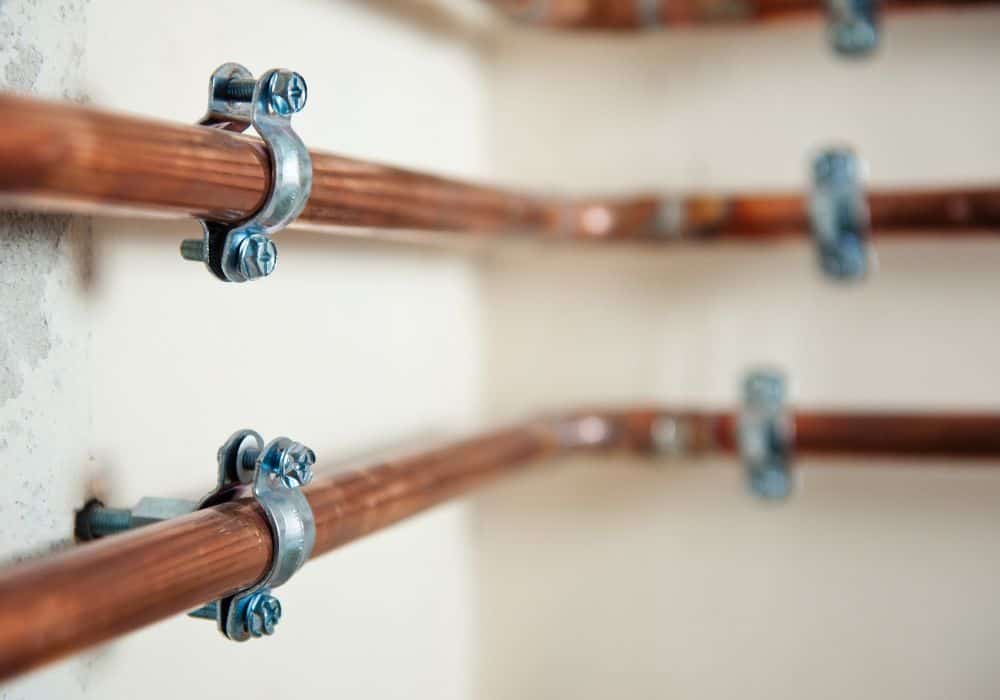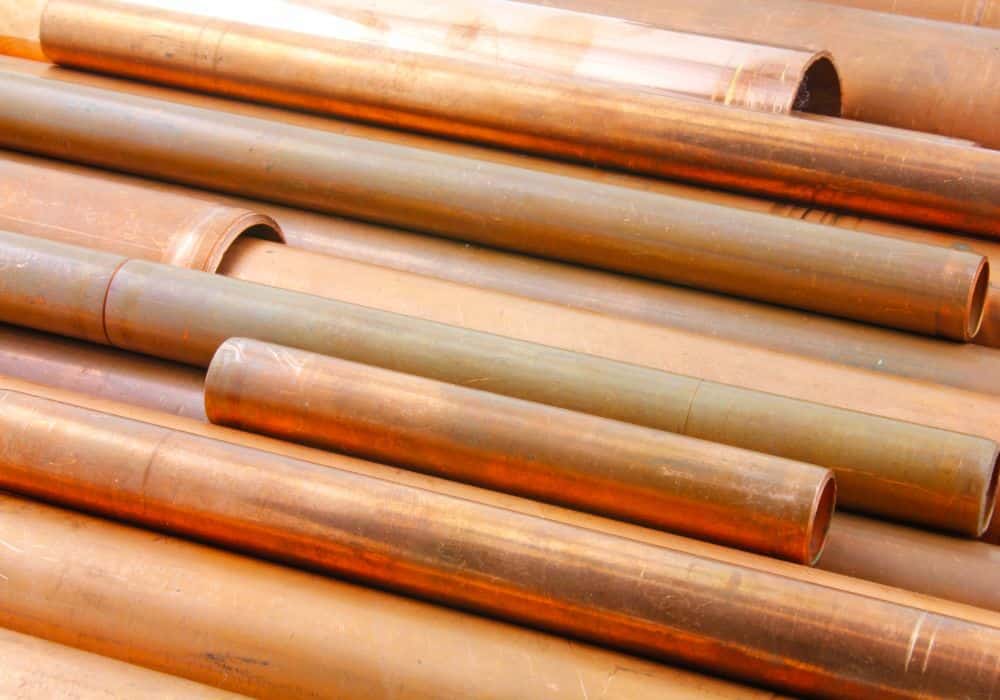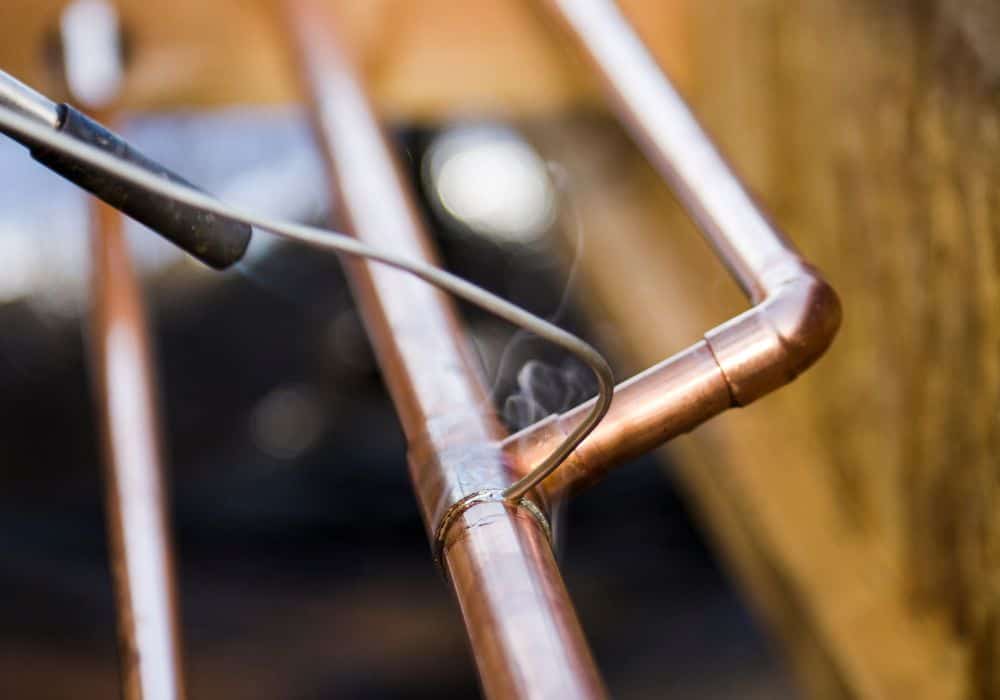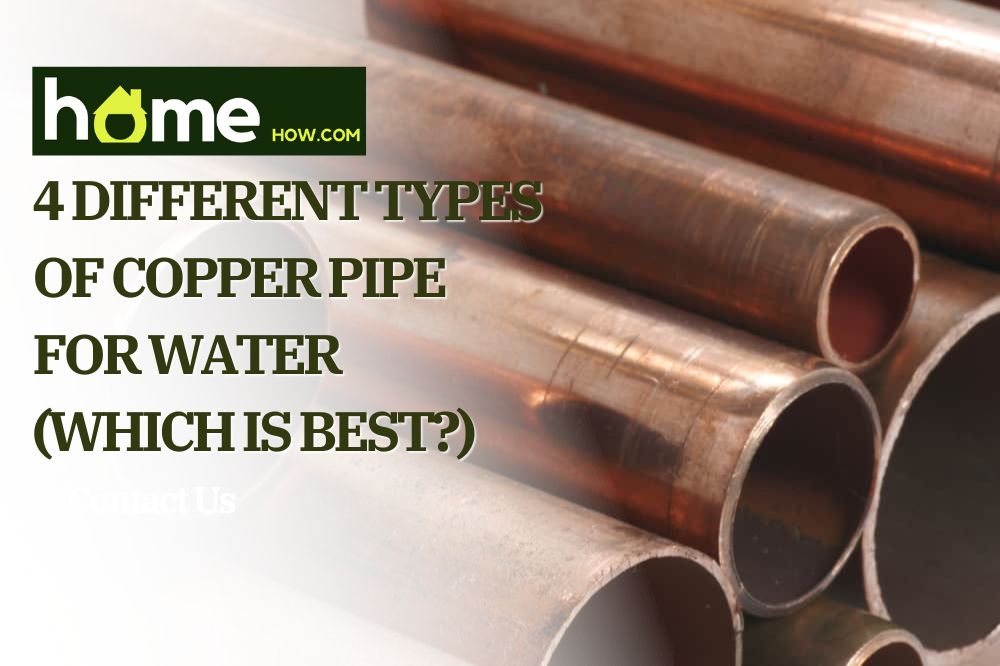Are you wondering what type of copper pipe for the water line suits your home? Then you’re in for a treat!
Here, I’ll explore the four types of copper pipes – and where they should be used with regard to water lines. That way, you could pick the right type for your plumbing system.
Let’s begin!
What Type of Copper Pipe Should Be Used For Water Lines?
Your choice should depend on where you plan on using the pipe. As there are different types of copper pipes, I’ll discuss where they’re best suited below.
1. Type K: for Main Water or Underground Lines
When it comes to building main water lines or underground installations, type K copper pipes fit the bill. Available in flexible (coiled) and rigid (10 or 20 feet long), this pipe is earmarked with a green stamp.
Type K has the thickest wall at 0.65 inches (for a 3/4-inch diameter) and 0.49 inches (for a 1/2-inch diameter pipe.) These measurements allow flexible type K pipes to withstand a high water pressure rating.
Flexible K pipes are also easier to run. They don’t require fittings, though they may be secured with compression fittings (more about this below.) They don’t need to be dug up that often too, which is why they’re often used for pipes that run underground.
Rigid type K copper tubes, on the other hand, boast of high durability. As such, they are often used for sprinklers, HVAC, oil, fire protection, and construction.
Given its thickness, it is no surprise that type K copper pipes are the most expensive on this list. That’s why when it comes to other types of water lines, the thinner (type L or M) copper plumbing types are more recommended.
2. Type L: for Interior Water Supply Lines
As the most common type of copper pipe, type L is often used in indoor residential plumbing. It’s also recommended for outdoor plumbing, apart from the replacement or repair of old branch lines.
With a wall thickness of 0.40 inches, type L copper pipes are also used in swimming pools, spas, HVAC, and fire protection. This also means that it can withstand hard water, which is something that can easily corrode thinner type M pipes.
Just like the type K pipe, blue-marked type L copper tubing is available in rigid and flexible forms.

3. Type M: for Branch Plumbing Lines
Type M copper pipe is often used to repair, extend, or replace interior water supply lines. This versatility is made possible by its 0.28-inch wall thickness and half-inch diameter.
Compared to the type L pipe, type M is not allowed in all areas. So if you’re planning on utilizing this, then you may want to read up on your local building codes first.
And, in case your location permits type M pipes, you’ll surely enjoy using this in your DIY projects. Not only are they easy to fit and cut, but they’re also cheaper (less copper is used in making this pipe, after all.)
Compared to the other pipes in this list, the red-marked type M pipe is only available in the rigid form.
4. Copper DWV: for Drain-Waste-Vent Pipes
Fitted with yellow markings, the DWV pipe speaks for itself. It is used in ground drains, waste, and vent lines.
It is important to note that copper DWV piping cannot withstand the pressures coming from municipal water systems for it only has a diameter of 1.5 inches and a wall thickness of 0.42 inches.
Despite this limitation, you can still fit copper DWV pipes in above-ground applications – as long as they have low-pressure ratings (max 15 psi.)
Currently, copper DWV is not a popular choice because alternatives such as polyvinyl chloride/PVC or ABS plastic pipe are cheaper. However, some old residential and commercial buildings continue to use this as they help preserve their ‘historic’ look.

How to Fit Copper Pipes
Now that you know which copper pipe best suits your water needs, then you can go ahead and install them yourself.
Depending on your budget or preference, you may go ahead and choose from these 4 ways of fitting copper pipes:
1. Clamp-on/Pro-set Fittings
Pro-set fittings are pre-made attachments that have O-rings inside. With the use of an installer, you can squeeze the fitting and make the O-ring watertight.
Applying pro-set fittings is easier, as you’ll see in this instructional video. The caveat, however, is that this will require you to purchase a costly installer.
2. Push-on Fittings
A push-on fitting comes with an O-ring and a stainless steel ring with teeth. Like the example above, it uses an installer to help the ‘teeth’ bite into the copper. This tool also enables the O-ring to form a watertight seal around the pipe.
Compared to pro-set fittings, push-on fittings are more expensive. Surprisingly, its installer is more affordable than the version used for clamp-on fittings.
Push-on fittings also require more hangers since they aren’t as strong as the other examples in this list.
3. Compression Fittings
As the name suggests, this is installed by compressing the brass ring between the nut and the fitting. The result: a watertight connection for your pipes.
While it’s cheaper than the two fittings above, it’s more laborious to install. You will need to turn two wrenches at the same time to make a good seal.
This difficulty shouldn’t stop you from using this, though. If you’re up to the challenge, all you need to do is follow this video on how to affix compression fittings like a pro.
4. Soldering
Soldering requires the use of a torch to heat the joint. Doing so applies solder to the fitting, thus creating a water-tight seal.
What are the Advantages and Disadvantages of Using Copper Pipes?
Copper pipes have long been utilized for water lines. In fact, its usage can be traced way back to ancient Egypt. As for modern times, copper pipes have been used for water distribution (at least in the US) since the 1960s.
Needless to say, there are many merits to using copper pipes – that’s why they’re preferred by many throughout the years. . But if you’re still deliberating whether or not you should use one for your water line, then let this list of pros/cons help you decide ASAP.
Advantages
- Durable
Copper pipes can last anywhere from 50-70 years, depending on usage, climate, and water quality. Thicker copper pipes (such as type K can) even withstand pressures up to 1000 psi.
Another good thing about copper pipes is they’re less likely to burst. They can withstand extreme heat and cold compared to a CPVC/PVC pipe, and as such could be fitted outside your home.
- Lightweight
Copper pipes are flexible and lightweight, which makes them relatively easy to use. This quality also makes it the preferred pipe by professionals and DIYers, especially when it comes to interior plumbing projects.
- Non-Contaminating
In contrast to iron, lead, or galvanized steel pipes, copper pipes are less likely to contaminate your water lines – as long as you maintain them well, of course!
- Fire Resistant
Thanks to copper’s high thermal rating, this type of water pipe is more resistant to fires. This is particularly important if you’re looking for types that will keep your home safer from fires.
- More Environment-Friendly
PVC or polyethylene/PEX pipes may be cheaper, but they release more harmful chemicals during the production process (compared to copper pipes.) The latter is recyclable too, for you can relocate and reuse these pipes as needed.

Disadvantages
- Costly
Copper pipes may be cheaper than galvanized steel pipes, but they’re still costlier than plastic pipes ($8,000 vs $4,000 starting cost.) If you ask me, it’s because you get what you pay for – literally.
- Corrodes in Acidic Water
Well water or acidic water (<7 pH) can end up corroding type M copper pipes. One sign that this is happening is the presence of the patina, which is the greenish discoloration that you see on the pipes.
Because of the possibility of corrosion, copper pipes should only be used if your water comes from a sanitary municipal supply.
Pro tip: you can also opt to use thicker type L pipes since they are more corrosion resistant.
- ‘Metallic’-Tasting Water
Speaking of corrosion, acidic water can make your copper pipes leak certain materials into the system. Although a little copper is good for your health, this ‘leak’ can make your water taste metallic in the long run.
Pro tip: Hot water corrodes copper, so make sure to run your tap on cold for one minute before drinking it.
Conclusion
There are 4 types of copper pipes that can be used for water lines. Your choice, however, should depend on how the pipe is going to be used.
In short, you should choose:
- Type K for main water or underground lines
- Type L for interior water supply lines
- Type M for branch plumbing
- Copper DWV for drain-waste-vent pipes
I hope this article has answered your question. if not, you can always post a comment and ask away!
